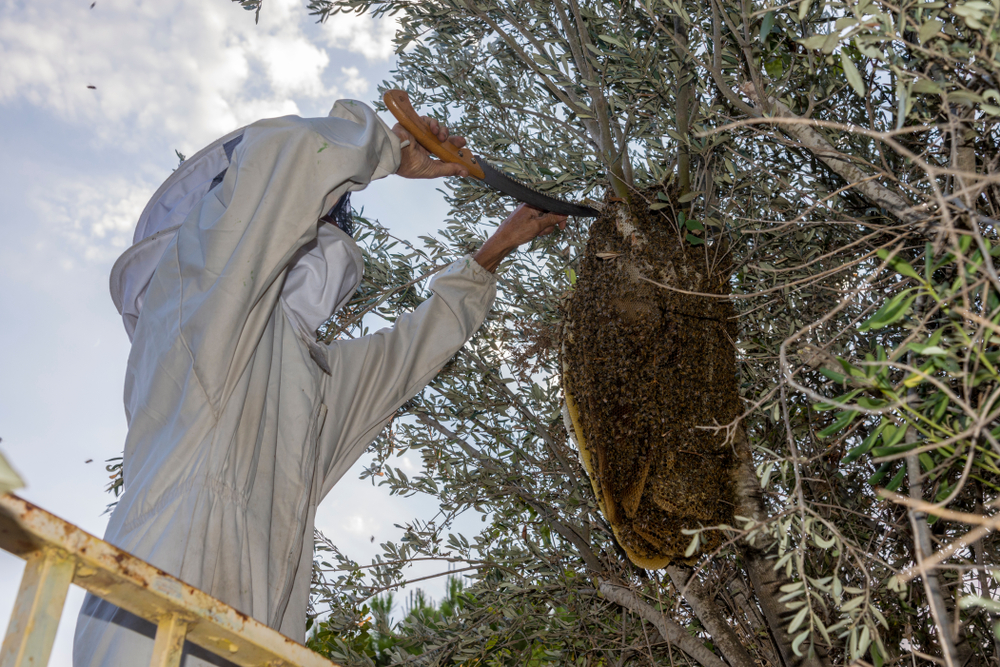Bee Hive Removal Made Easy: Safe and Fast Solutions
Get expert bee hive removal tips to keep your home safe. Learn simple, safe, and effective ways to handle unwanted hives today.
Effective Strategies for Safe Bee Hive Removal
Facing an unwanted bee hive removal? Learn how to remove it safely with our guide. We cover understanding bee behavior, assessing the hive, and choosing the right removal method.
- Understanding bee behavior is essential for safe hive removal, as it helps identify correct species and their natural tendencies.
- Cost of bee hive removal varies based on hive size, location, and additional structural repair needs, with average costs around $445.
- Utilizing humane removal methods, such as live removal and trap-out techniques, is preferable to extermination due to ecological considerations.
Understanding Bee Behavior
Understanding bee behavior is crucial for effective bee hive removal. Swarming is a natural behavior of honey bees where they move to find a new home. During this process, honey bees are typically relocating to a new hive, which is a reproductive way for them to survive. Recognizing this is important because killing a honey bee swarm harms the population, as swarming is their method of reproduction.
Properly identifying honey bees before removal helps avoid confusion with other insects like wasps, which require different handling techniques. The honey bee species often involved in hive removal is Apis mellifera, known for its critical role in pollination. This species, in particular, contributes significantly to the pollination of crops and natural vegetation, making them invaluable to our ecosystem.
Bees perform orientation flights during their initial foraging bees to memorize landmarks, which aids in their efficient foraging. This behavior highlights their sophisticated navigation skills and the importance of their presence in the environment. Recognizing these behaviors can help in planning a removal strategy that is safe and considerate of the bees’ natural tendencies.
Assessing the Situation
Before proceeding with bee removal, it’s essential to properly identify the hive’s location and type. Bees can create nests in challenging areas such as walls or utility poles. Assessing the hive’s size and location helps determine the safest and most effective removal strategy. Understanding the potential risks, such as structural damage or allergic reactions, is vital during this assessment.
Hives located in urban settings may pose unique challenges due to the proximity to human activity. The type of structure housing the hive can influence the removal approach. For example, a wild hives inside a wall may require different techniques compared to one in an open area. Proper assessment tailors the removal process to the specific situation, minimizing risks and maximizing efficiency.
Methods of Bee Hive Removal
Various methods exist for bee hive removal, each suited to different situations. The least invasive way to remove a colony involves locating it and determining the easiest removal approach. Using a smoker to calm the bees often makes the process safer and more manageable.
Bee hive removal methods can range from live removal to trap-out techniques and, in some cases, extermination. Each method involves specific procedures and considerations. The hive’s location, size, and specific challenges determine the right method. Familiarity with these methods aids in making informed decisions for safe and effective bee removal.
Live Removal
Live removal is a method focused on capturing and relocating live bees. The primary goal is to find and capture the queen bee, ensuring that the rest of the colony follows her to the new location. This method requires capturing the bees and placing them into a hive box to ensure their survival and continued productivity. By relocating the bees to a new site, this method allows them to continue their essential role in pollination and honey production.
This method is often preferred as it preserves the bee population and minimizes harm. When left undisturbed, bees can be safely relocated, contributing to the health of the local ecosystem.
Live removal is particularly effective for honey bee hives, aligning with the goal of maintaining bee populations.
Trap Out
Trap-out involves setting up a system that lets bees exit their hive but prevents their return. This technique is particularly useful for hives located inside walls or other hard-to-reach places. By preventing bees from re-entering their original hive, they are encouraged to settle into a new hive box placed nearby.
This method effectively reduces bee populations in difficult spaces without direct extermination. Over a short period, the bees will gradually relocate to the new honey bee hive, effectively managing the colony.
The trap-out method is a humane way to rid your home of bees while allowing them to continue their vital ecological role.
Extermination
Extermination, considered a last resort, is used primarily for aggressive or problematic hives. This method involves applying pesticides to eliminate the bees effectively. However, it is important to note that using pesticides can pose risks to unintended targets, including beneficial insects and other wildlife.
The widespread use of pesticides has contributed to the decline in bee populations, impacting ecosystems and agriculture. Therefore, extermination should only be used when necessary, and other methods have proven ineffective.
Costs Associated with Bee Hive Removal
The costs associated with bee hive removal can vary widely. The average removal cost ranges from $135 to $1,065, with homeowners typically paying around $445. These costs depend on various factors, including the size of the hive, its location, and the method used for removal.
These cost factors are vital for planning and budgeting bee removal. Breaking down the costs based on specific criteria allows homeowners to make informed decisions and prepare for potential expenses. Let’s explore these factors in more detail.
Cost by Hive Size
The size of the hive significantly influences removal costs. Small hives typically cost around $118 to remove, with costs ranging from $100 to $300. Medium hives generally cost around $450 to remove, while large hives can cost approximately $1,170. Extra-large hives may cost up to $2,000 to remove, reflecting their size and complexity.
These variations underscore the need to assess the hive size before removal. Larger hives, due to their complexity, often require more resources and time to remove safely. Being aware of these costs helps homeowners budget appropriately for bee hive removal.
Cost by Location
Geographic location also affects bee removal costs. Urban areas typically have higher removal costs compared to rural regions due to accessibility and local beekeeper availability. Higher removal costs in urban areas stem from increased demand and regulatory requirements.
Factors like accessibility, demand, and beekeeper availability influence these cost differences. Urban homeowners should prepare for potentially higher expenses when planning for bee hive removal.
Additional Costs
Homeowners may face additional expenses besides the primary removal costs. Hiring engineers or contractors for structural repairs, for example, can add to the overall cost.
These additional costs should be factored into the budget for bee hive removal, especially if the hive has caused property damage.
Safety Precautions During Removal
Safety is of utmost importance during bee hive removal. A full bee suit significantly reduces the likelihood of bee stings. A bee suit provides protection from head to toe, ensuring that you are shielded from potential stings during the removal process.
A first aid kit is crucial for addressing potential bee stings during removal. Quick access to a first aid kit can effectively manage a sting.
Such precautions are vital for a safe and successful bee removal experience.
Finding a Local Beekeeper
A local beekeeper can be a valuable resource for safe and effective bee removal. A local beekeeping organization or the Agricultural Commissioner can help locate beekeepers willing to assist. These organizations often list experienced beekeepers who can assist in removing and relocating bee hives.
Websites like beeswarmed.org help report swarms and connect with local beekeepers. These online resources can help you find experienced beekeepers quickly and efficiently. Working with local beekeepers ensures worker bees are removed safely and relocated to continue their essential ecological role.
Preventing Future Infestations
Preventing future bee infestations helps avoid recurring problems. Eliminating potential attractants like sugary foods and beverages from outdoor areas reduces the chances of bees returning. A clean environment, particularly by removing food sources, deters bees from settling on your property again.
Regular maintenance, like painting or staining wood surfaces, can deter carpenter bees. Such preventative measures help keep your property bee-free, reducing the likelihood of future bee hive removals.
Understanding bee behavior, assessing the situation, and choosing the right removal method are crucial steps in safe and effective bee hive removal. Considering the associated costs, taking necessary safety precautions, and finding a local beekeeper can make the process smoother and more efficient. Preventing future infestations through regular maintenance and cleanliness is also essential. By following these guidelines, you can handle bee hive removal responsibly and ensure the well-being of both your property and the bee population.
Frequently Asked Questions
How to remove bee hive?
Removing a bee hive should be handled by professionals; contact a pest control service experienced in bee removal or seek a local beekeeper. Attempting to remove it yourself is not advisable without proper experience and equipment.
Does homeowners insurance cover bee removal?
Homeowners insurance typically does not cover bee removal or damage caused by bees, as these situations are generally considered exclusions in most policies. It’s advisable to check your specific policy for any unique coverage details.
How much does it cost to remove a hive?
Removing a beehive typically costs around $445, but prices can range from $135 to $1,065. If structural damage is involved, costs could escalate to nearly $2,500.
Can I get a bee hive removed for free?
You may be able to have a beehive removed for free if a local beekeeper is willing to relocate it, but be prepared for a possible donation or fee if additional equipment is needed. It’s best to reach out to local beekeepers to discuss your specific situation.
How do I identify a honey bee hive?
To identify a honey bee hive, look for enclosed spaces such as walls or utility poles where bees are actively entering and exiting. Ensuring correct identification is essential before considering any removal actions.



